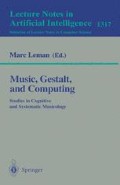Abstract
Music theory must try to deal with emergent qualities, such as contour, texture, timbre and tone semantics, and this necessitates recognizing musical objects as holistic entities. Representations by shapes can be useful here, as shapes are inherently holistic. The idea of shapes is seen as applicable to several aspects and modalities at work in musical imagery, providing images at various levels of resolution of both the unfolding sounds and the sound-producing actions. The paradigm of shapes is seen as well supported by several contemporary domains of thought, but in need of extensive development as an alternative to more abstract approaches in music theory.
Preview
Unable to display preview. Download preview PDF.
References
Barthes, R. (1977). Image-music-text. Glasgow: Fontana/Collins.
Black, M. (1962). Models and metaphors. Ithaca, London: Cornell University Press.
Bregman, A. (1990). Auditory scene analysis: The perceptual organization of sound. Cambridge, MA: The MIT Press.
Chion, M. (1983). Guide des objets sonores. Paris: Editions Buchet/Chastel.
Cogan, R. (1984). New images of musical sound. Cambridge, MA: Harvard University Press.
Damasio, A. (1989). Time-locked multiregional retroactivation: A systems-level proposal for the neural substrates of recall and recognition. Cognition, 33, 25–62.
de Man, P. (1978). The epistemology of metaphor. Critical Inquiry, 5, 13–20.
Denis, M. (1989). Image et cognition. Paris: Presses Universitaires de France.
Deutsch, D. (1984). Musical space. In W. Crozier & A. Chapman (Eds.), Cognitive processes in the perception of art. Amsterdam: Elsevier Science Publishers.
Finke, R. A. (1989). Principles of mental imagery. Cambridge, MA: The MIT Press.
Godøy, R., (1993). Formalization and epistemology. Oslo: Det historisk-filosofiske fakultet.
Haberlandt, K. (1994). Cognitive psychology. Needham Heights, MA: Allyn and Bacon.
Harnad, S. (Ed.). (1987). Categorical perception. Cambridge: Cambridge University Press.
Holyoak, K., & Thagard, P. (1995). Mental leaps: Analogy in creative thought. Cambridge, MA: The MIT Press.
Husserl, E. (1980). Vorlesungen zur Phänomenologie des inneren Zeitbewusstseins. Tübingen: Max Nimeyer Verlag.
Johnson, M. (1987). The body in the mind. Chicago, IL: The University of Chicago Press.
Koffka, K. (1963). Principles of Gestalt psychology. New York, NY: Harcourt, Brace, and World.
Köhler, W. (1947). Gestalt psychology. New York, NY: Liveright.
Kosslyn, S. (1994). Image and brain. Cambridge, MA: The MIT Press.
Lakoff, G. (1987). Women, fire and dangerous things. What categories reveal about the mind. Chicago, IL: The University of Chicago Press.
Leman, M. (1995). Music and schema theory: Cognitive foundations of systematic musicology. Berlin, Heidelberg: Springer-Verlag.
McAdams, S. (1984). The auditory image: A metaphor for musical and psychological research on auditory organization. In W. Crozier & A. Chapman (Eds.), Cognitive processes in the perception of art. Amsterdam: Elsevier Science Publishers.
Miller, I. (1982). Husserl's account of our temporal awareness. In H. Dreyfus (Ed.), Husserl, intentionality, and cognitive science. Cambridge, MA: The MIT Press.
Moore, F. (1990). Elements of computer music. Englewood Cliffs, NJ: Prentice Hall.
Persichetti, V. (1962). Twentieth century harmony. London: Faber and Faber.
Petitot, J. (1985x). Les catastrophes de la parole de Roman Jacobson á René Thom. Paris: Maline.
Petitot, J. (1985b). Morphogenèse du sens I. Paris: Presses Universitaires de France.
Reisberg, D. (Ed.). (1992). Auditory imagery. Hillsdale, NJ: Lawrence Erlbaum Associates.
Ricoeur, P. (1981). Hermeneutics & the human sciences. Cambridge, Paris: Cambridge University Press, Editions de la Maison des Sciences de l'Homme.
Risset, J. (1991). Timbre analysis by synthesis: Representations, imitations and variants for musical composition. In G. De Poli, A. Piccialli, & C. Roads (Eds.), Representations of musical signals. Cambridge, MA: The MIT Press.
Schaeffer, P. (1966). Traité des objets musicaux: Essai interdisciplines. Paris: Editions du Seuil.
Stevens, K. (1972). The quantal nature of speech: Evidence from articulatoryacoustic data. In E. David & P. Denes (Eds.), Human communication: A unified view. New York, NY: McGraw-Hill.
Stumpf, C. (1883/90). Tonpsychologie. Leipzig: Hirzel. (two volumes)
Sudnow, D. (1978). Ways of the hand. Cambridge, MA: Harvard University Press.
Sweetser, E. (1990). From etymology to pragmatics. Cambridge: Cambridge University Press.
Thom, R. (1983). Paraboles et catastrophes. Paris: Flammarion.
Tufte, E. (1983). The visual display of quantitative information. Cheshire, CT: Graphics Press.
Tufte, E. (1990). Envisioning information. Cheshire, CT: Graphics Press.
von Ehrenfels, C. (1988). On “Gestalt Qualities”. In B. Smith (Ed.), Foundations of Gestalt theory. Munich, Vienna: Philosophia Verlag. (Original work published 1890)
Wertheimer, M. (1967). Laws of organization in perceptual forms. In W. Ellis (Ed.), A source book of Gestalt psychology. London: Routledge & Kegan Paul.
Wessel, D. (1985). Timbre space as a musical control structure. In C. Roads & J. Strawn (Eds.), Foundations of computer music. Cambridge, MA: The MIT Press.
Author information
Authors and Affiliations
Editor information
Rights and permissions
Copyright information
© 1997 Springer-Verlag Berlin Heidelberg
About this paper
Cite this paper
Godøy, R.I. (1997). Knowledge in music theory by shapes of musical objects and sound-producing actions. In: Leman, M. (eds) Music, Gestalt, and Computing. JIC 1996. Lecture Notes in Computer Science, vol 1317. Springer, Berlin, Heidelberg. https://doi.org/10.1007/BFb0034109
Download citation
DOI: https://doi.org/10.1007/BFb0034109
Published:
Publisher Name: Springer, Berlin, Heidelberg
Print ISBN: 978-3-540-63526-0
Online ISBN: 978-3-540-69591-2
eBook Packages: Springer Book Archive

